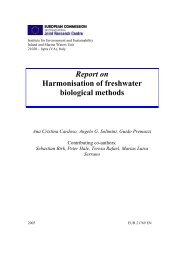Lakes and Watercourses
Lakes and Watercourses
Lakes and Watercourses
You also want an ePaper? Increase the reach of your titles
YUMPU automatically turns print PDFs into web optimized ePapers that Google loves.
Light conditions<br />
Introduction<br />
Light conditions are crucial for the survival of many organisms. Water<br />
quality in this respect is assessed on the basis of absorbency readings<br />
taken from filtered water at a wavelength of 420 nm in a photometer or<br />
equivalent readings taken using a colour comparator, using brownishyellow<br />
platinum chloride as a reference. A high water table, eg, in bogs<br />
<strong>and</strong> marshes, results in run-off with a high humus content <strong>and</strong> hence a<br />
higher colour figure. Various chemical, photochemical <strong>and</strong> biological<br />
processes cause a certain amount of discoloration. This means that lakes<br />
with a long retention time are less discoloured than those with rapid<br />
turnover. From some points of view, a high concentration of humic<br />
matter is advantageous, since it provides scope for complexing, which<br />
reduces the toxicity of metals.<br />
The turbidity of the water is assessed by analysing light dispersion<br />
measured according to the FNU scale. These readings quantify the<br />
particulate content of the water in the form of clayey matter as well as<br />
organic matter such as humus floccules, plankton etc.<br />
Turbidity is determined electronically using a turbidimeter in<br />
accordance with the Swedish st<strong>and</strong>ard. Particles in the water scatter light<br />
<strong>and</strong>, after calibration, the intensity of this light is used as a measure of<br />
turbidity. One complication is that readings are affected by the concentration<br />
as well as the nature of the particles. The turbidity of natural<br />
running water is mainly caused by inorganic particles. The main source<br />
of material like this, which causes turbidity, is probably erosion.<br />
Inorganic matter has a high density <strong>and</strong> therefore sediments fairly<br />
quickly. <strong>Lakes</strong> thus serve as clarification basins, where the predominant<br />
cause of turbidity is usually organic matter.<br />
Measuring the Secchi depth of lakes gives an indication of the optical<br />
characteristics of the water. Secchi depth readings are taken using a<br />
Secchi dish in situ, which indicates the overall effects of water colour <strong>and</strong><br />
turbidity on light penetration. The Secchi depth thus gives a direct,<br />
simple measure of the optical characteristics of the water. It is generally<br />
considered that the Secchi depth represents the depth reached by<br />
approximately 10 per cent of natural light. A Secchi depth figure can be<br />
32















![Accommodation booking form [PDF]](https://img.yumpu.com/39471785/1/184x260/accommodation-booking-form-pdf.jpg?quality=85)

